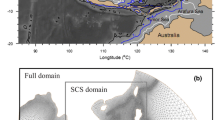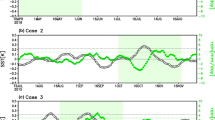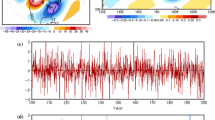Abstract
Sea surface temperature (SST) anomalies can induce anomalous convection through surface evaporation and low-level moisture convergence. This SST forcing of the atmosphere is indicated in a positive local rainfall–SST correlation. Anomalous convection can feedback on SST through cloud-radiation and wind-evaporation effects and wind-induced oceanic mixing and upwelling. These atmospheric feedbacks are reflected in a negative local rainfall–SST tendency correlation. As such, the simultaneous rainfall–SST and rainfall–SST tendency correlations can indicate the nature of local air–sea interactions. Based on the magnitude of simultaneous rainfall–SST and rainfall–SST tendency correlations, the present study identifies three distinct regimes of local air–sea interactions. The relative importance of SST forcing and atmospheric forcing differs in these regimes. In the equatorial central-eastern Pacific and, to a smaller degree, in the western equatorial Indian Ocean, SST forcing dominates throughout the year and the surface heat flux acts mainly as a damping term. In the tropical Indo-western Pacific Ocean regions, SST forcing and atmospheric forcing dominate alternatively in different seasons. Atmospheric forcing dominates in the local warm/rainy season. SST forcing dominates with a positive wind-evaporation feedback during the transition to the cold/dry season. SST forcing also dominates during the transition to the warm/rainy season but with a negative cloud-radiation feedback. The performance of atmospheric general circulation model simulations forced by observed SST is closely linked to the regime of air–sea interaction. The forced simulations have good performance when SST forcing dominates. The performance is low or poor when atmospheric forcing dominates.














Similar content being viewed by others
References
Adler RF, Huffman GJ, Chang A, Ferraro R, Xie P, Janowiak J, Rudolf B, Schneider U, Curtis S, Bolvin D, Gruber A, Susskind J, Arkin P (2003) The version 2 global precipitation climatology project (GPCP) monthly precipitation analysis (1979-present). J Hydrometeor 4:1147–1167
Alexander MA, Bladé I, Newman M, Lanzante JR, Lau N-C, Scott JD (2002) The atmospheric bridge: the influence of ENSO teleconnections on air–sea interaction over the global oceans. J Clim 15:2205–2231
Annamalai H, Murttugudde R, Potema J, Xie S-P, Wang B (2003) Coupled dynamics over the Indian Ocean: spring initiation of the zonal mode. Deep Sea Res Part II Top Stud Oceanogr 50:2305–2330
Baquero-Bernal A, Latif M, Legutke S (2002) On the dipole like variability of sea surface temperature in the tropical Indian Ocean. J Clim 15:1358–1368
Barsugli JJ, Battisti DS (1998) The basic effects of atmosphere-ocean thermal coupling on midlatitude variability. J Atmos Sci 55:477–493
Behera SK, Salvakar PS, Yamagata T (2000) Simulation of interannual SST variability in the tropical Indian Ocean. J Clim 13:3487–3499
Bretherton CS, Battisti DS (2000) An interpretation of the results from atmospheric general circulation models forced by the time history of the observed sea surface temperature distribution. Geophys Res Lett 27:767–770
Cayan DR (1992) Latent and sensible heat flux anomalies over the northern oceans: driving the sea surface temperature. J Phys Oceanogr 22:859–881
Chambers DP, Tapley BD, Stewart RH (1999) Anomalous warming in the Indian Ocean coincident with El Niño. J Geophys Res 104:3035–3047
Charney J, Shukla J (1981) Predictability of monsoons. In: Lighthill J, Pearce RP (eds) Monsoon dynamics. Cambridge University Press, New York, pp 99–110
Chou S-H, Nelkin E, Ardizzone J, Atlas RM, Shie C-L (2003) Surface turbulent heat and momentum fluxes over global oceans based on Goddard satellite retrievals, version 2 (GSSTF2). J Clim 16:3256–3273
Chou S-H, Nelkin E, Ardizzone J, Atlas RM (2004) A comparison of latent heat fluxes over global oceans for four flux products. J Clim 17:3973–3989
Frankignoul C, Kestenare E (2002) The surface heat flux feedback. Part I: estimates from observations in the Atlantic and the North Pacific. Clim Dyn 19:633–647
Frankignoul C, Czaja Z, L’Heveder B (1998) Air–sea feedback in the North Atlantic and surface boundary conditions for ocean models. J Clim 11:2310–2324
Frankignoul C, Kestenare E, Mignot J (2002) The surface heat flux feedback. Part II: direct and indirect estimates in the ECHAM4/OPA8 coupled GCM. Clim Dyn 21:27–51
Frankignoul C, Kestenare E, Botzet M, Carril AF, Drange H, Pardaens A, Terray L, Sutton R (2004) An intercomparison between the surface heat flux feedback in five coupled models, COADS and the NCEP reanalysis. Clim Dyn 22:373–388
Gill AE (1980) Some simple solutions for heat-induced tropical circulation. Quart J Roy Meteor106:447–462
Hendon H (2003) Indonesia rainfall variability: impacts of ENSO and local air–sea interaction. J Clim 16:1775–1790
Huang B, Kinter III JL (2002) Interannual variability in the tropical Indian Ocean. J Geophys Res 107:3199. doi:10.1029/2001JC001278
Iizuka S, Matsuura T, Yamagata T (2000) The Indian Ocean SST dipole simulated in a coupled general circulation model. Geophys Res Lett 27:3369–3372
Jin F-F, An S-I (1999) Thermocline and zonal advective feedbacks within the equatorial ocean recharge oscillator model for ENSO. Geophys Res Lett 26:2989–2992
Kalnay E, et al (1996) The NCEP/NCAR 40-year reanalysis project. Bull Am Meteor Soc 77:437–471
Kang I-S, An S-I, Jin F-F (2001) A systematic approximation of the SST anomaly equation for ENSO. J Meteor Soc Japan 79:1–10
Kang I-S, et al (2002) Intercomparison of GCM simulated anomalies associated with the 1997–98 El Niño. J Clim 15:2791–2805
Kinter JL III, DeWitt DG, Dirmeyer PA, Fennessy MJ, Kirtman BP, Marx L, Schneider EK, Shukla J, Straus D (1997) The COLA atmosphere-biosphere general circulation model, vol. 1: formulation. COLA Technical Report 51, COLA, Calverton, 46 pp
Kinter JL III, Fennessy MJ, Krishnamurthy V, Marx L (2004) An evaluation of the apparent interdecadal shift in the tropical divergent circulation in the NCEP-NCAR reanalysis. J Clim 17:349–361
Kitoh A, Arakawa O (1999) On overestimation of tropical precipitation by an atmospheric GCM with prescribed SST. Geophys Res Lett 26:2965–2968
Klein SA, Sode BJ, Lau N-C (1999) Remote sea surface temperature variations during ENSO: evidence for a tropical atmospheric bridge. J Clim 12:917–932
Krishna Kumar K, Hoerling MP, Rajagopalan B (2005) Advancing dynamical prediction of Indian monsoon rainfall. Geophys Res Lett 32:L08704. doi:10.1029/2004GL021979
Krishnamurthy V, Kirtman BP (2003) Variability of the Indian Ocean: relation to monsoon and ENSO. Quart J Roy Meteor Soc 129:1623–1646
Kumar A, Hoerling MP (1998) Specification of regional sea surface temperatures in atmospheric general circulation model simulations. J Geophys Res 103:8901–8907
Lau N-C, Nath MJ (1996) The role of the “Atmospheric Bridge” in linking tropical Pacific ENSO events to extratropical SST anomalies. J Clim 9:2036–2057
Lau N-C, Nath MJ (2000) Impact of ENSO on the variability of the Asian-Australian monsoons as simulated in GCM experiments. J Clim 13:4287–4309
Lau N-C, Nath MJ (2003) Atmosphere-ocean variations in the Indo-Pacific sector during ENSO episodes. J Clim 16:3–20
Lau N-C, Nath MJ (2004) Coupled GCM simulation of atmosphere-ocean variability associated with zonally asymmetric SST changes in the tropical Indian Ocean. J Clim 17:245–265
Li T, Zhang Y, Lu E, Wang D (2002) Relative role of dynamic and thermodynamic processes in the development of the Indian Ocean dipole: an OGCM diagnosis. Geophys Res Lett 29:2110. doi:10.1029/2002GL015789
Matsuno T (1966) Quasi-geostrophic motions in the equatorial area. J Meteor Soc Japan 44:25–42
Murtugudde R, Busalacchi AJ (1999) Interannual variability in the dynamics and thermodynamics of the tropical Indian Ocean. J Clim 12:2300–2326
Murtugudde R, McCreary JP Jr, Busalacchi AJ (2000) Oceanic processes associated with anomalous events in the Indian Ocean with relevance to 1997–1998. J Geophys Res 105:3295–3306
Nicholls N (1978) Air–sea interaction and the quasi-biennial oscillation. Mon Wea Rev 106:1505–1508
Nicholls N (1979) A simple air–sea interaction model. Quart J Roy Meteor Soc 105:93–105
Reynolds RW (1988) A real-time global sea surface temperature analysis. J Clim 1:75–86
Reynolds RW, Marsico DC (1993) An improved real-time global sea surface temperature analysis. J Clim 6:114–119
Reynolds RW, Rayner NA, Smith TM, Stokes DC, Wang W (2002) An improved in situ and satellite SST analysis for climate. J Clim 15:1609–1625
Roebber PJ, Tsonis AA, Elsner JB (1997) Do climate simulations from models forced by averaged sea surface temperature represent actual dynamics? Nonlin Proc Geophys 4:93–100
Saji NH, Goswami BN, Vinayachandran PN, Yamagata T (1999) A dipole mode in the tropical Indian Ocean. Nature 401:360–363
Saravanan R (1998) Atmospheric low-frequency variability and its relationship to midlatitude SST variability: studies using the NCAR climate system model. J Clim 11:1386–1404
Saravanan R, McWilliams JC (1998) Advective ocean-atmosphere interaction: an analytical stochastic model with implications for decadal variability. J Clim 11:165–188
Shinoda T, Alexander MA, Hendon HH (2004) Remote response of the Indian Ocean to interannual SST variations in the tropical Pacific. J Clim 17:362–372
Shukla J (1998) Predictability in the midst of chaos: a scientific basis for climate forecasting. Science 282:728–731
Sperber KR, Palmer TN (1996) Interannual tropical rainfall variability in general circulation model simulations associated with the atmospheric model intercomparison project. J Clim 9:2727–2750
Trenberth KE, Shea DJ (2005) Relationships between precipitation and surface temperature. Geophys Res Lett 32:L14703. doi:10.1029/2005GL022760
Trenberth KE, Branstator GW, Karoly D, Kumar A, Lau N-C, Ropelewski C (1998) Progress during TOGA in understanding and modeling global teleconnections associated with tropical sea surface temperatures. J Geophys Res 103:14291–14324
von Storch J-S (2000) Signature of air–sea interactions in a coupled atmosphere-ocean GCM. J Clim 13:3361–3379
Wang B, Zhang Q (2002) Pacific-East Asian teleconnection. Part II: how the Philippine Sea anomalous anticyclone is established during El Niño development. J Clim 15:1643–1658
Wang B, Wu R, Fu X (2000) Pacific-East Asian teleconnection: how does ENSO affect East Asian climate? J Clim 13:1517–1536
Wang B, Wu. R, Li T (2003) Atmosphere-warm ocean interaction and its impacts on the Asian-Australian monsoon variation. J Clim 16:1195–1211
Wang B, Kang I-S, Li J-Y (2004) Ensemble simulation of Asian-Australian monsoon variability by 11 AGCMs. J Clim 17:803–818
Wang B, Ding Q, Fu X, Kang I-K, Jin K, Shukla J, Doblas-Reyes F (2005) Fundamental challenge in simulation and prediction of summer monsoon rainfall. Geophys Res Lett 32:L15711. doi:10.1029/2005Gl022734
Webster PJ, Magaña VO, Palmer TN, Shukla J, Tomas RA, Yanai M, Yasunari T (1998) Monsoons: processes, predictability, and the prospects for prediction. J Geophys Res 103:14451–14510
Webster PJ, Moor AM, Loschnigg JP, Leben RR (1999) Coupled ocean-atmosphere dynamics in the Indian Ocean during 1997–98. Nature 401:356–360
Witternberg AT, Anderson JL (1998) Dynamical implications of prescribing part of a couple system: results from a low-order model. Nonlin Proc Geophys 5:167–179
Wu R, Kirtman BP (2005) Roles of Indian and Pacific Ocean air–sea coupling in tropical atmospheric variability. Clim Dyn 25:155–170
Wu R, Kirtman BP, Pegion K (2006) Local air–sea relationship in observations and model simulations. J Clim 19:4914–4932
Xie P, Arkin PA (1997) Global precipitation: A 17-year monthly analysis based on gauge observations, satellite estimates, and numerical model outputs. Bull Am Meteor Soc 78:2539–2558
Xie S-P, Annamalai H, Schott FA, McCreary JP (2002) Structure and mechanisms of South Indian Ocean climate variability. J Clim 15:864–878
Yu L, Reinecker MM (1999) Mechanisms for the Indian Ocean warming during the 1997–98 El Niño. Geophys Res Lett 26:735–738
Yu L, Weller RA, Sun B (2004) Improving latent and sensible heat flux estimates for the Atlantic Ocean (1988–1999) by a synthesis approach. J Clim 17:373–393
Zhang Y, Rossow WB, Lacis AA, Oinas V, Mishchenko MI (2004) Calculation of radiative fluxes from the surface to top of atmosphere based on ISCCP and other global data sets: refinement of the radiative transfer model and the input data. J Geophys Res 109:D19105. doi:10.1029/2003JD004457
Acknowledgments
The authors appreciate insightful comments of Dr Harry Hendon and an anonymous reviewer. This research was supported by grants from the National Science Foundation ATM-0332910, the National Ocean and Atmospheric Administration NA04OAR4310034 and NA05OAR4311135, and the National Aeronautics and Space Administration NNG04GG46G.
Author information
Authors and Affiliations
Corresponding author
Rights and permissions
About this article
Cite this article
Wu, R., Kirtman, B.P. Regimes of seasonal air–sea interaction and implications for performance of forced simulations. Clim Dyn 29, 393–410 (2007). https://doi.org/10.1007/s00382-007-0246-9
Received:
Accepted:
Published:
Issue Date:
DOI: https://doi.org/10.1007/s00382-007-0246-9




